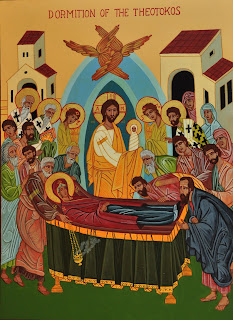I know that
if you are visiting Rejoiceicons today, you expect I will continue with a discussion
about my current icon project, or something I have learned about icons through recent
research. You can see it’s been a while
since I last wrote. I recently read of a
noted author who confessed to being very bad about keeping up with his blog,
and I certainly understand and agree. So
much of life seems to get in the way, although I can hardly say I am attempting
the Great American Novel as this fellow is.
But bear
with me.
I have
just recently completed the southern trek to my Florida winter home, from New
York State. I was at a local Florida
mall today and discovered a display of bonsai plants, which interest me as well
as several of my children – the ones who inherited their father’s green thumb. To let the seller know the level of my
commitment to bonsai, I told him I was a snowbird to which he replied, “I won’t
hold that against you”. In retrospect I
just realized that this was a pretty snotty thing to say to a lady of my age
and dignity. Among other things, I must
be losing my speed on the uptake.
But
snowbirding, as with age, is not for the sissies among us. I told an Indian friend that it was a schizophrenic
existence and she was immediately shocked that I would admit to the disease,
but it is so. Arrival at one place or
the other after 6 months in “the other” means the beginning of a mental
re-training period. Where do I keep the
cereal? What happened to that blue
casserole dish? Why did I bring white
slacks south – that’s bringing coals to New Castle. And at church, wait a minute, I’ll remember
that tone if you hum a bar or two. Shucks,
did I forget the rent check for Florida?
Even
before the trek and the retraining comes the thinking and then the packing. The thinking begins soon after I arrive in
one place or the other, when I start a list that is headed “things NOT to bring
back!” and the list gets longer and longer. And something is always forgotten. As the months go by (we’re talking north or
south), all the things I’ve put off and need to take care of, become condensed
into a month, then a week, then--- on another “to do” list.
The
night before The Big Trek South, daughter Mary comes to the rescue and restores
sanity and calm. This has been happening
for 8 winters now, and when Carlo approached the Problem the first year, Mary
timorously offered her opinion, and for the rest of his life (sadly only a few
years) Mary was The Packer. Sort of Pack
Rat becomes Packer. That girl can
squeeze stuff in places a bat couldn’t fit into!
Oh but
the real fun is The Day We Leave – in either direction. Easily accessible behind the driver’s seat is
a special pink plastic bag containing rubber gloves, disinfectant spray, a wet
cloth, paper towels – and cat food. The
last thing the night before, we have covered the interior of the car with a 9 x
12 sheet of el cheapo plastic. The only thing exposed is The Litter Box. In the morning, The Cat is deposited in the
back seat next to it and begins to yowl.
We wave good-bye and take off in whichever direction the calendar tells
us.
The Cat
is called Gatsby and for all of his 11 years he has lived by a Rule of 5. In 5 miles or 5 minutes (his choice) he
empties every orifice of his body.
Having everything at the ready, I (because the “we” suddenly isn’t
interested) use the contents of the pink bag to eradicate all evidence of the
Rule of 5. In about 30 minutes, The Cat
is a contented as the proverbial cow. We
stay overnight at a motel and he guards the car from inside. Next morning is as if he has never heard of
the Rule and we continue peacefully to our destination, with Gatsby curled
around the gear shift of the car.
I won’t
go into the inevitable unpacking and reorientation that occurs after the
arrival Here or There, but please forgive and understand the delay since my
last blog and I really, really hope to improve.
That’s what something is supposed to do with age, right – improve?
I
promise that my next blog will be completely serious…
























